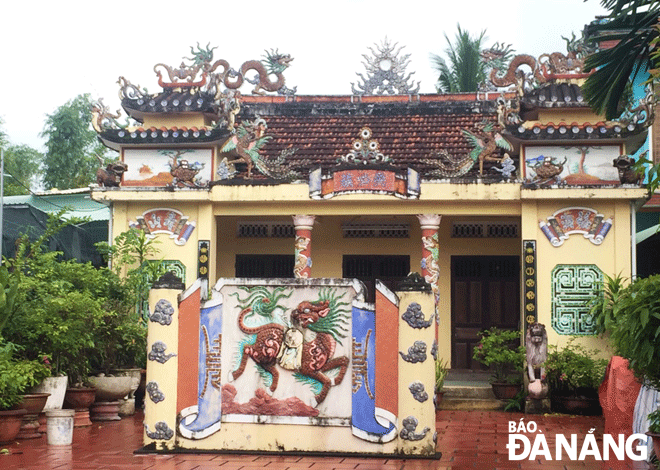The Phong Le ancient Village has been founded more than 500 years ago under the Hong Duc reign. It stretches from Hoa Vang District's Hoa Chau’s Commune to Hoa Thuan Dong and Hoa Thuan Tay wards in Cam Le District. This village is considered as an ancient village in the heart of Da Nang as it preserves many unique and valuable cultural heritage of Da Nang, and the Quang region as a whole.

The Phong Le Village is considered as an ancient village in the heart of Da Nang as it preserves many unique and valuable cultural heritage of Da Nang, and the Quang region as a whole. Photo: X.D
The village of differences
Phong Le is a village with many differences compared to other villages in the region. First of all, we must mention the Phong Le Communal House, recognized by the Da Nang People Committee as a city-level historical-cultural relic in 2007. This communal house has a yin-yang tiled roof. On the roof of the communal house, the panels and tail corners are covered with dragons and unicorns, especially with the symbol of a soaring buffalo horn - an architecture rarely seen in communal houses in our country.
Researcher Bui Van Tieng, the Chairman of the Da Nang Historical Science Association, said that the Phong Le communal house is also locally called Shen Nong or Muc Dong Temple as this place is not dedicated to worship Thanh Hoang or the Village God but worships Shen Nong, the god of agriculture.
The annual Shen-Nong worship event is held solemnly across the country. However, the Phong Le Village in Da Nang is the only one place in Viet Nam to hold the Muc Dong Festival. The event honours the children who tend the water buffalos, and it is one of the city’s most important festivals.
Mr. Tien said “Rarely is there a communal house in Da Nang like the Phong Le Communal House where some famous scholars like Cao Ba Quat and Phan Boi Chau visited and left their autographs in Chinese characters hung in the house. There is also a rare communal house in Da Nang that used to temporarily worship seven ancient bronze Buddha statues like the Phong Le village’s pagoda”.
Regarding the language, the Phong Le Village has used Vietnamese pronouns like ‘may’ and ‘tao’ which typically means ‘you’ and ‘me’ in English, respectively. These pronouns are the other superior versus inferior forms of first and second person which are commonly used in familiar social contexts, such as between family members (e.g., older sister to younger sister) while ‘Sao’ typically means "why" or "how" in English and it is used to ask for an explanation or a reason for something. These words have been used by many generations in the Phong Le Village, while such its neighbors as Cam Ne, Dong Phuoc, Cam Le all say ‘mi’, ‘tau’, ‘rang’ to express the same meaning.
According to researcher Vo Van Thang, the former Director of the Museum of Cham Sculpture, this difference can be assumed to be due to the ancestors of some major clans living in the Phong Le Village coming from the northern region. Therefore, the whole villagers used the same words and phases, and this characteristic is still maintained stably for a long time, not mixed with other villages. Besides, this difference may also be due to the fact that the clans coming from other regions settled in Phong Le later than the clans that came to neighboring villages.
Furthermore, there are religious relics in Phong Le hamlet such as: Am Linh, Bach Ma Thai Giam, Ba Giang, and Ong temples, all of which are related with the village's traditional beliefs.
Especially, the Phong Le land is the birthplace of national heroes, including legendary generals Ong Ich Khiem, and Ong Ich Duong. In terms of culinary culture, Phong Le has popular delicacies such as Phong Nam Thorn leaf cake, Quang Chau and Cam Le sesame dried cake.
Combining preservation of the ancient village with tourism development
Due to cultural exchanges and blending with other places, the Phong Le Village needs to experience the richness of other cultures and incorporate their best parts into its identity, without losing its own. It is also crucial for the village to protect and promote the cultural values of the current religious and belief festivals to make the village more inviting to domestic and foreign tourists.
According to Dinh Thi Trang, the Chairwoman of the Da Nang Folk Arts Association, urbanization has changed the village surroundings that challenged and changed many of the cultural practices and beliefs in this village. Hence, she stressed the need for the city to create a harmonious balance between urbanization and conservation in rural areas while making a planning for Hoa Vang District and especially the Phong Le Village in a bid to make the village stand out.
Researcher Ho Xuan Tinh, a member of the Executive Committee of the Da Nang Cultural Heritage Association, said that the city is trying to turn itself into a civilized and modern city, along with a best place in Viet Nam to live and visit. Although some urban areas will be certainly expanded more, retaining a village in the heart of the city is also necessary. The Phong Le villagers will enjoy great benefits after their village becomes an attractive destination for domestic and foreign tourists. The development of tourist services will bring benefits to the villagers. The villagers must have a part to play in protecting their local cultural heritage. The cultural and tourism value of the Hoa Vang - Cam Le region will develop sustainably with the participation of local communities.
Reporting by T.Duyen - Translating by T.An